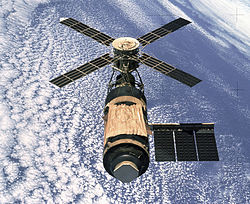From WikiChip
Difference between revisions of "microprocessors used in spacecrafts"
(→1970s) |
(we shouldn't skip the 60s) |
||
| Line 1: | Line 1: | ||
Over the years various [[microprocessors]] have been used in many different spacecrafts. Microprocessors are used in spacecrafts are designed to be exceptionally reliable and [[radiation hardening|highly durable]]. Because of that, often the same set of chips that have been tested and proven to work are used in many spacecrafts. Below is a [[list of microprocessors used in spacecrafts]]. | Over the years various [[microprocessors]] have been used in many different spacecrafts. Microprocessors are used in spacecrafts are designed to be exceptionally reliable and [[radiation hardening|highly durable]]. Because of that, often the same set of chips that have been tested and proven to work are used in many spacecrafts. Below is a [[list of microprocessors used in spacecrafts]]. | ||
| + | |||
| + | == 1960s == | ||
| + | {| class="wikitable" | ||
| + | |- | ||
| + | ! Year !! Picture !! Spacecraft !! Description | ||
| + | |- | ||
| + | | 1959-1963 || [[File:Mercury Friendship7 Bassett Celestia.jpg|200px]] || [[Wikipedia:Mercury spacecraft|Mercury spacecraft]] || The [[Wikipedia:Mercury spacecraft|Mercury spacecraft]], NASA's first human spaceflight, had barely enough space for a single occupant. The spacecraft had no independent maneuvering capabilities - relying completely on the Atlas booster rocket. Because of that, it was unnecessary for the spacecraft to have a dedicated on-board computer. Limited functionality was done by various smaller systems. | ||
| + | |- | ||
| + | | 1962-1966 || [[File:Gemini spacecraft.jpg|200px]] || [[Wikipedia:Gemini Spacecraft|Gemini Spacecraft]] || The [[Wikipedia:Gemini Spacecraft|Gemini Spacecraft]], part of Project Gemini, NASA's second human spaceflight program, that ran from 1965-1966, carried an on-board digital computer called the [[Gemini Guidance Computer]]. The computer, which weighted fifty pounds and measured nineteen inches long, had about 19.5KB of memory. | ||
| + | |- | ||
| + | | 1961-1972 || [[File:Apollo CSM lunar orbit.jpg|200px]] || [[Wikipedia:Apollo spacecraft|Apollo spacecraft]] || The [[Wikipedia:Apollo spacecraft|Apollo spacecraft]], part of the [[Wikipedia:Apollo program]], NASA's third human spaceflight program, that ran from 1961 to 1972, carried an on-board digital computer called the [[Apollo Guidance Computer]]. The 16-bit computer weighted 70 pounds and consumed 55W had a clock speed of 2.048 MHz. | ||
| + | |} | ||
== 1970s == | == 1970s == | ||
Revision as of 01:22, 8 February 2014
Over the years various microprocessors have been used in many different spacecrafts. Microprocessors are used in spacecrafts are designed to be exceptionally reliable and highly durable. Because of that, often the same set of chips that have been tested and proven to work are used in many spacecrafts. Below is a list of microprocessors used in spacecrafts.
1960s
| Year | Picture | Spacecraft | Description |
|---|---|---|---|
| 1959-1963 | 200px | Mercury spacecraft | The Mercury spacecraft, NASA's first human spaceflight, had barely enough space for a single occupant. The spacecraft had no independent maneuvering capabilities - relying completely on the Atlas booster rocket. Because of that, it was unnecessary for the spacecraft to have a dedicated on-board computer. Limited functionality was done by various smaller systems. |
| 1962-1966 |  |
Gemini Spacecraft | The Gemini Spacecraft, part of Project Gemini, NASA's second human spaceflight program, that ran from 1965-1966, carried an on-board digital computer called the Gemini Guidance Computer. The computer, which weighted fifty pounds and measured nineteen inches long, had about 19.5KB of memory. |
| 1961-1972 |  |
Apollo spacecraft | The Apollo spacecraft, part of the Wikipedia:Apollo program, NASA's third human spaceflight program, that ran from 1961 to 1972, carried an on-board digital computer called the Apollo Guidance Computer. The 16-bit computer weighted 70 pounds and consumed 55W had a clock speed of 2.048 MHz. |
1970s
| Year | Picture | Spacecraft | Description |
|---|---|---|---|
| 1971 |  |
Pioneer 10 | The Pioneer 10, which was launched on March 3, 1972, became the first spacecraft to achieve escape velocity from the Solar System. The spacecraft's process were made of individual transistor-transistor logic chips. A common myth is that the Intel 4004 powered the Pioneer 10, this, however, incorrect. |
| 1973 | Pioneer 11 | The Pioneer 11, was launched on April 6, 1973 in order to study the Asteroid belt. Just like it's twin prob, the Pioneer 10, its CPU was also a custom-designed TTL CPU. | |
| 1973 |  |
Skylab | The Skylab, which was launched on May 14, 1973, and operated until 1979, used an IBM System/4Pi model TC-1 (Tactical Computer), a miniaturized and hardened version of the IBM System/360 computers. |